Zirconia veneers, a cutting-edge dental solution, are thin yet robust coverings constructed from durable zirconia material. Zirconia veneers serve cosmetic and functional purposes, offering an aesthetically pleasing and resilient option for enhancing smiles. A key benefit of zirconia veneers lies in their ability to provide a personalised treatment plan tailored to the patient's desires and dental condition. The veneers are known for their precision, aesthetic alignment, and consideration of functional aspects, ensuring an enhanced appearance and optimal oral function.
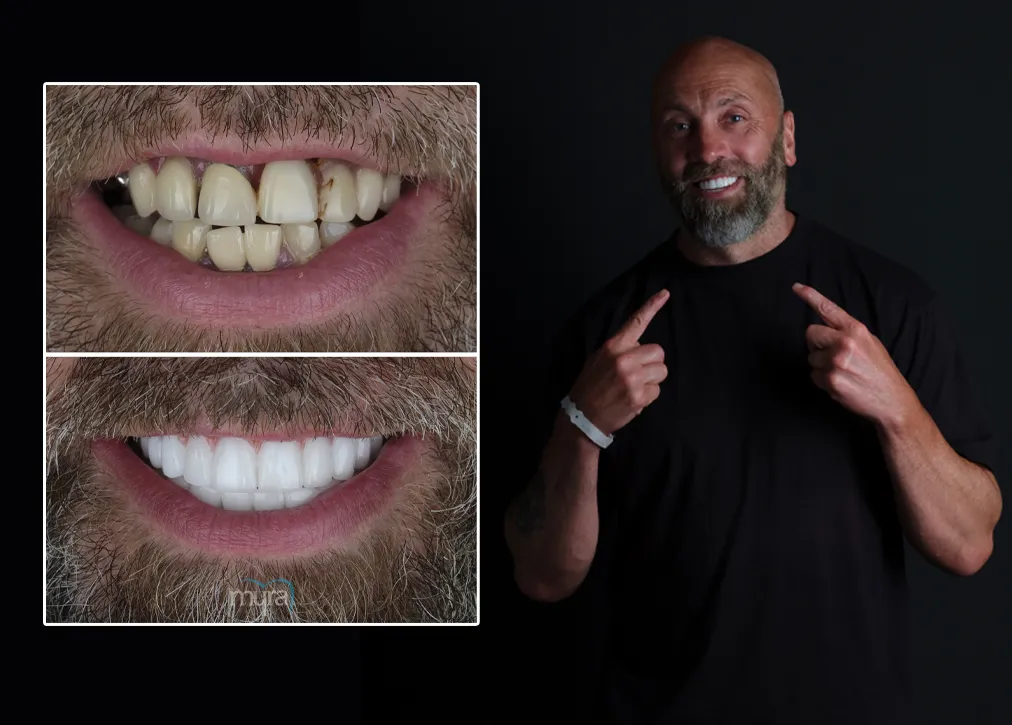
The zirconia veneer process involves meticulous steps, including consultation, treatment planning, tooth preparation, impressions, temporary veneers, veneer fabrication, try-in and adjustments, final bonding, and final polish. Dentists ensure a personalised approach during the procedure, assessing each tooth's unique features and aligning the treatment with the patient's aesthetic objectives. Zirconia veneers work by combining strength and aesthetics, and the material's properties make them less likely to chip, crack, or break compared to alternatives such as Emax.
Dentists recommend zirconia veneers when patients seek a durable and aesthetic solution for improving the way they look with their teeth. Zirconia veneers are a multipurpose solution for a variety of dental issues, including discolouration, misalignment, and damage. Zirconia veneers are superior to emax veneers for many reasons, including their strength and durability, which make them an excellent choice for patients with a wide range of dental issues.
There are some things to think about with zirconia veneers, despite all the advantages. The preparation process involves more tooth reduction than with emax veneers, but the strength and durability they offer are worth it. Zirconia veneers are not the most budget-friendly choice, and they leave some patients with sensitive teeth.
Zirconia veneers present a state-of-the-art solution for individuals seeking a durable and aesthetically pleasing enhancement for their zirconia teeth. The choice between Emax vs Zirconia veneers depends on individual preferences, with Zirconia standing out for its robustness and ability to deliver lasting results. Zirconia teeth veneers provide a thorough and customised solution, enhancing the appearance and functionality of the teeth and allowing for a self-assured and beautiful smile.
What is Zirconia Veneers?
Zirconia veneers represent an innovative dental treatment crafted through a specialised process utilising zirconium, a white alloy, without incorporating metal into its substructure. The aesthetic dentistry solution involves the precise processing of zirconium, offering exceptional features such as high heat and corrosion resistance. The primary material, zirconium, allows the veneers to closely mimic the appearance of natural teeth, making them highly valuable in cosmetic dentistry. Renowned for their durability and aesthetic appeal, zirconia veneers exhibit remarkable light transmittance, providing a transparent and lifelike appearance. Their versatility allows safe application on front and back teeth, catering to various dental needs.
Zirconia veneers have garnered significance due to their tissue-friendly nature and compatibility with gums, reducing the risk of gum disease development. The name "zirconium" derives from the Arabic word "Zargun," meaning golden in colour. Zirconium, a naturally occurring element with an atomic number of 40, is purified into a silver-coloured metal, which, when combined with oxygen, forms zirconia, a robust and highly biocompatible ceramic. The discovery of zirconium dates back to the 18th century, when the German chemist Martin Heinrich Klaproth successfully extracted zirconium oxide from the mineral zircon. The utilisation of zirconia in dentistry experienced significant advancements in the late 20th century, leading to its widespread adoption for dental applications.
The application of zirconia in dentistry gained prominence in 1969 when Helmer and Driskell conducted the first scientific study on the biomedical properties of zirconia. Garvie and Nicholson in 1972 showed that mixing zirconia with oxides such as calcia, yttria, and magnesia stabilises its tetragonal modification, making ceramics that are less likely to crack. Yttria-stabilised zirconia found applications in orthopaedics for hip and knee joint replacements, earning it the nickname "cement steel" due to its unique crystalline reticulation that changes under force, effectively sealing cracks and supporting the growth of blood vessels and bone cells.
What is the Importance of Zirconia Veneers?
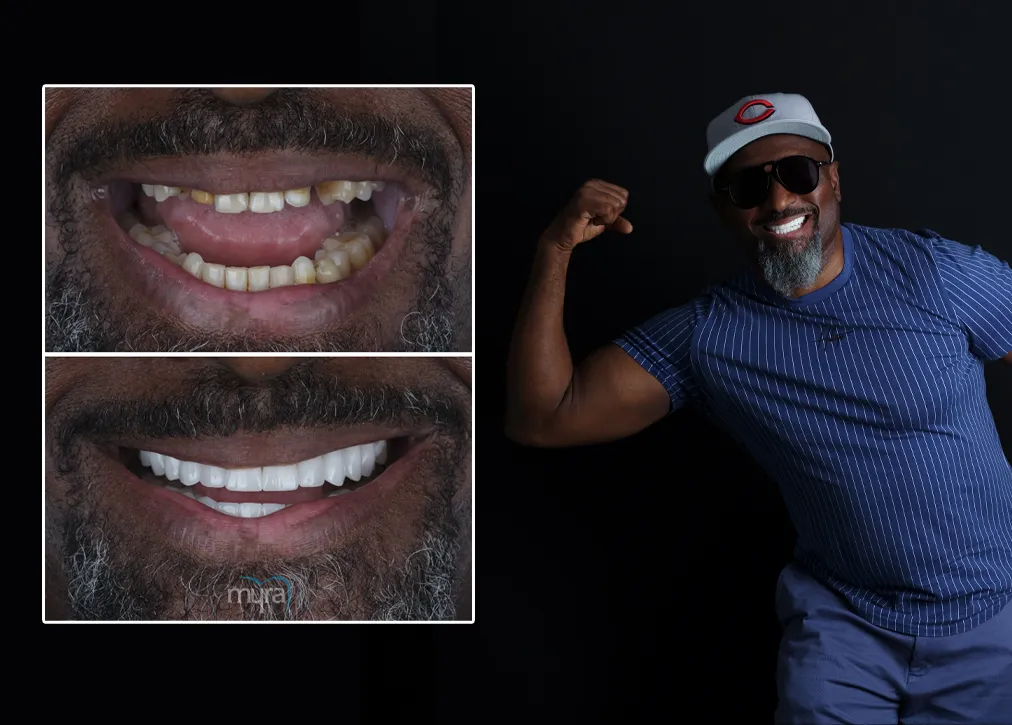
The importance of zirconia veneers is focused on individuals grappling with oral health issues, offering a multifaceted solution that extends beyond mere aesthetically pleasing improvements.
Zirconia veneers emerge as a pivotal option due to their composition, which is constructed from a robust and durable material. Zirconia, known for its high heat and corrosion resistance, ensures that the veneers withstand the rigours of daily use, providing long-lasting solutions for individuals dealing with various dental issues.
Zirconia veneers play a vital role in mimicking the appearance of natural teeth beyond their structural strength. The characteristic is of utmost significance for individuals seeking functional solutions and ones that seamlessly integrate with their existing dentition. The ability of zirconia veneers to closely replicate the look of natural teeth contributes significantly to the satisfaction and confidence of individuals who have been self-conscious about their dental imperfections.
Zirconia veneers offer a pleasing sensory experience. The transparency and lifelike appearance of these veneers enhance tactile and visual satisfaction for individuals, fostering a sense of comfort and naturalness. The sensory aspect becomes particularly crucial for people undergoing dental procedures, where the experience contributes to the success and acceptance of the treatment.
The time efficiency of zirconia veneers becomes a notable advantage. The expedited process of crafting and applying these veneers enables individuals to achieve transformative results in a relatively short time. Its feature is especially helpful for people who need quick solutions, whether they are looking to improve their looks or fix a dental problem.
The importance of zirconia veneers lies in their ability to provide a durable, aesthetically pleasing, and time-efficient solution for individuals with various tooth problems. Zirconia veneers are developing as an all-encompassing and valuable alternative in contemporary dentistry due to their structural resilience, capacity to imitate the looks of real teeth, enhancement of sensory satisfaction, and rapid turnaround.
How Does Zirconia Veneers Work?
Zirconia veneers work by undergoing a careful and exacting procedure to attain their final form, combining cutting-edge technology with dental expertise to deliver transformative results.
The process begins with a comprehensive assessment by a qualified dentist. The dentist evaluates the patient's oral health, discusses expectations, and determines the suitability of zirconia veneers for the individual's specific needs at the outset. The personalised approach ensures that the treatment aligns with the patient's dental goals.
The dentist begins the preparation phase once the decision to proceed with zirconia veneers is made. It involves the removal of a thin layer of enamel from the front surface of the teeth receiving the veneers. The step is crucial for creating space and ensuring a seamless fit for the veneers, although it is minimally invasive compared to other dental procedures.
The dentist takes impressions of the treated teeth following tooth preparation. The impressions serve as the foundation for crafting customised zirconia veneers that perfectly match the patient's dental anatomy. The use of advanced digital technology in impression-taking enhances precision and contributes to the accuracy of the final veneers.
The impressions are sent to a dental laboratory, where skilled technicians utilise computer-aided design and manufacturing (CAD/CAM) technology. The advanced system allows the precise milling of zirconia blocks, shaping them into veneers that align with the individual's unique dental specifications.
They undergo a meticulous quality check to ensure they meet the highest standards once the zirconia veneers are fabricated. The final step involves bonding the veneers to the prepared teeth using dental cement. The bonding process is carefully executed, ensuring a secure and durable attachment.
The culmination of the process results in zirconia veneers that address aesthetic concerns and contribute to the strength and resilience of the treated teeth. The integration of cutting-edge technology, personalised care, and dental craftsmanship underscores the efficacy of zirconia veneers in enhancing smiles and promoting oral well-being.
When Does the Dentist Recommend Zirconia Veneers to Their Clients?
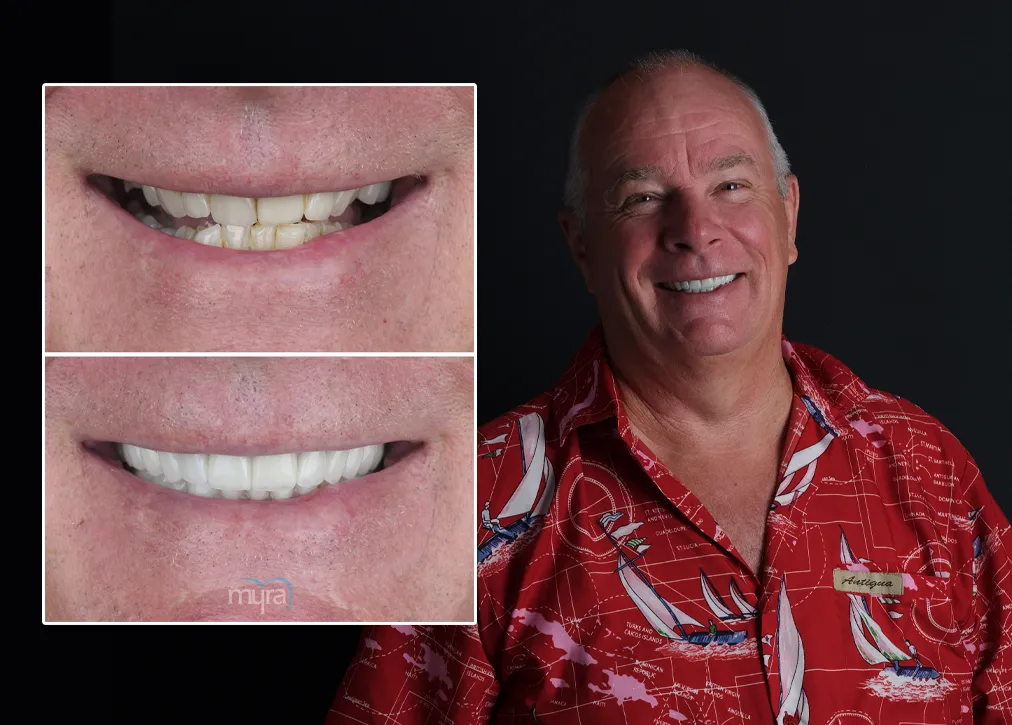
Dentists recommend zirconia veneers to their clients in several scenarios, primarily when addressing cosmetic or functional dental concerns. The recommendations align with specific dental conditions or patient preferences, making zirconia veneers a versatile and effective solution.
Zirconia veneers are frequently recommended to address cosmetic imperfections such as stained or discoloured teeth. Their ability to mimic the natural translucency of teeth makes them an ideal choice for enhancing the whole look of a smile.
Individuals with chipped or cracked teeth benefit from zirconia veneers. The material's strength and durability make it an excellent option for restoring the integrity of damaged teeth, providing functionality and aesthetics.
Zirconia veneers are recommended for individuals with misaligned or irregularly shaped teeth. They offer a minimally invasive way to create a more uniform and harmonious appearance, improving the alignment of the teeth.
Patients dealing with gaps or spaces between their teeth are entitled to a recommendation for zirconia veneers. The veneers effectively close gaps, providing a seamless and aesthetically pleasing result.
Zirconia veneers are recommended for patients who prioritise a natural-looking smile. The material's light transmittance and colour compatibility with natural teeth contribute to a realistic and lifelike appearance.
Individuals falling into any of these categories have the option of zirconia veneers as a tailored solution to meet their specific dental needs and achieve a confident and aesthetically pleasing smile. Consulting with a qualified cosmetic dentist provides personalised insights into the suitability of zirconia veneers for individual cases.
Cosmetic dentists or prosthodontists recommend and apply zirconia veneers. The specialists have expertise in aesthetic dentistry and tooth restoration, ensuring that the placement of zirconia veneers meets functional and cosmetic goals. Patients considering zirconia veneers must consult with a qualified cosmetic dentist to discuss their specific needs and explore the suitability of the treatment option.
What is the Procedure for Zirconia Veneers?
The procedures for Zirconia Veneers are listed below.
- Initial Visit: The dentist assesses the patient's oral health during the initial consultation, discusses their cosmetic goals, and determines the suitability of zirconia veneers. The subsequent step involves a thorough examination, normally including X-rays.
- Treatment Planning: The dentist develops a personalised treatment plan based on the assessment. It includes considerations for the number of veneers needed, the desired shade, and any additional procedures required for optimal results.
- Tooth Preparation: A minimal amount of enamel is removed to prepare the teeth for veneer placement. The step ensures a proper fit and bonding of the zirconia veneers. Some cases require little to no tooth reduction, depending on the specific type of veneer used.
- Impressions: Impressions of the teeth are taken after tooth preparation. The impressions serve as a model for crafting custom-made zirconia veneers that perfectly match the patient's natural teeth in terms of size, shape, and colour.
- Temporary Veneers (if necessary): Temporary veneers are placed in some cases while the permanent ones are being fabricated. The temporary veneers protect the prepared teeth and maintain aesthetics during the waiting period.
- Veneer Fabrication: Skilled dental technicians use the impressions to create zirconia veneers in a dental laboratory. The fabrication process ensures precision and customisation, resulting in veneers that seamlessly integrate with the patient's smile.
- Veneer Bonding: The dentist checks their fit and appearance before proceeding with the bonding process once the zirconia veneers are ready. The veneers are carefully bonded to the prepared teeth using dental cement, ensuring a secure and long-lasting attachment.
- Final Adjustments: The dentist makes any necessary final adjustments to ensure the bite is comfortable and the veneers align perfectly with the surrounding teeth. It involves shaping or polishing the veneers for optimal aesthetics.
- Post-Treatment Care: The patient receives guidance on post-treatment care, including oral hygiene practises and potential lifestyle adjustments. Regular check-ups are scheduled to track the state of the zirconia veneers and address any concerns.
Zirconia Before & After Pictures
Zirconia teeth before and after pictures in Turkey show remarkable transformations, boosting patient confidence and satisfaction. Turkey's competitive pricing and high-quality care make it a preferred destination for dental tourism, combining advanced technology with skilled professionals to deliver excellent outcomes.
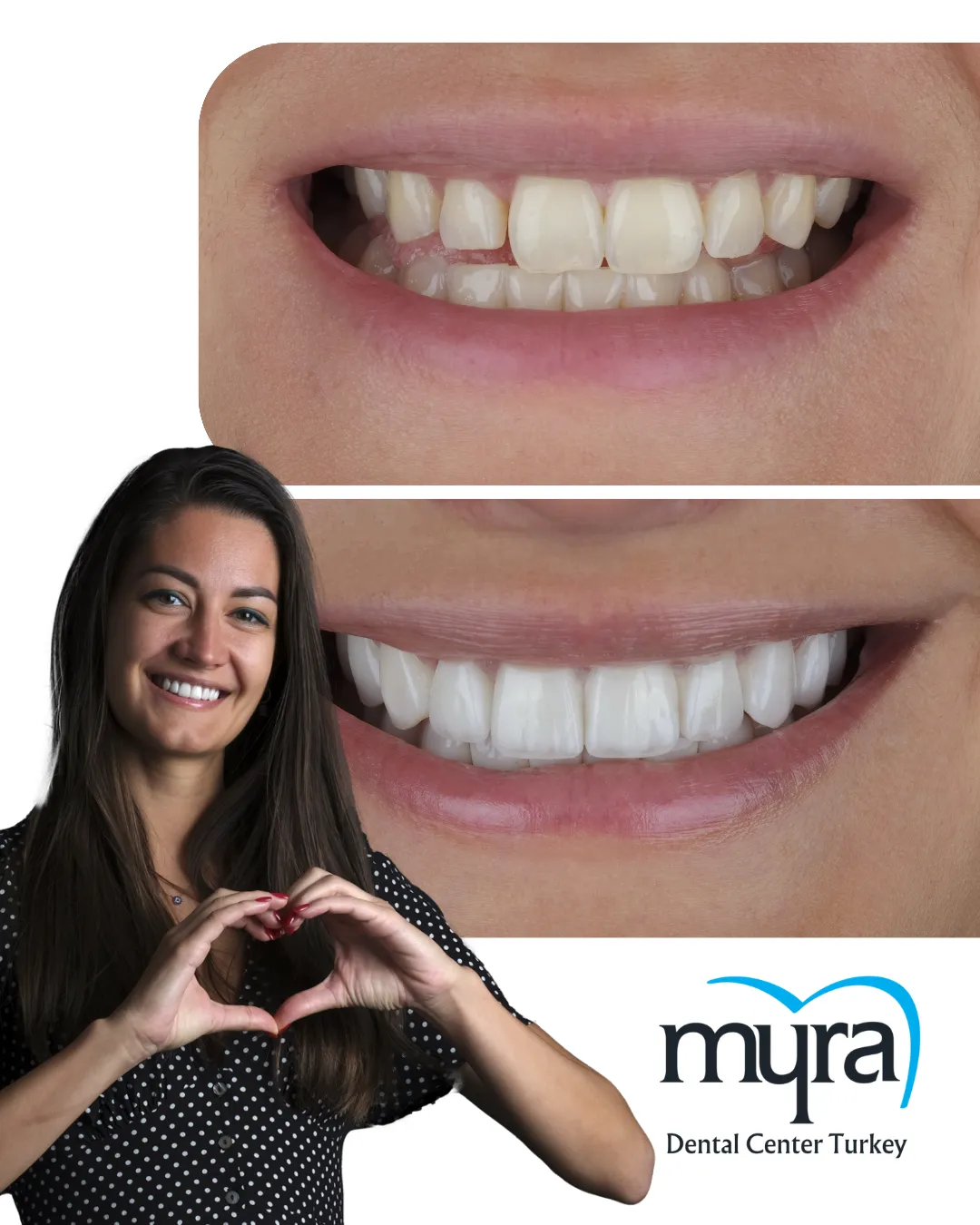
Turkey teeth pictures with bl2
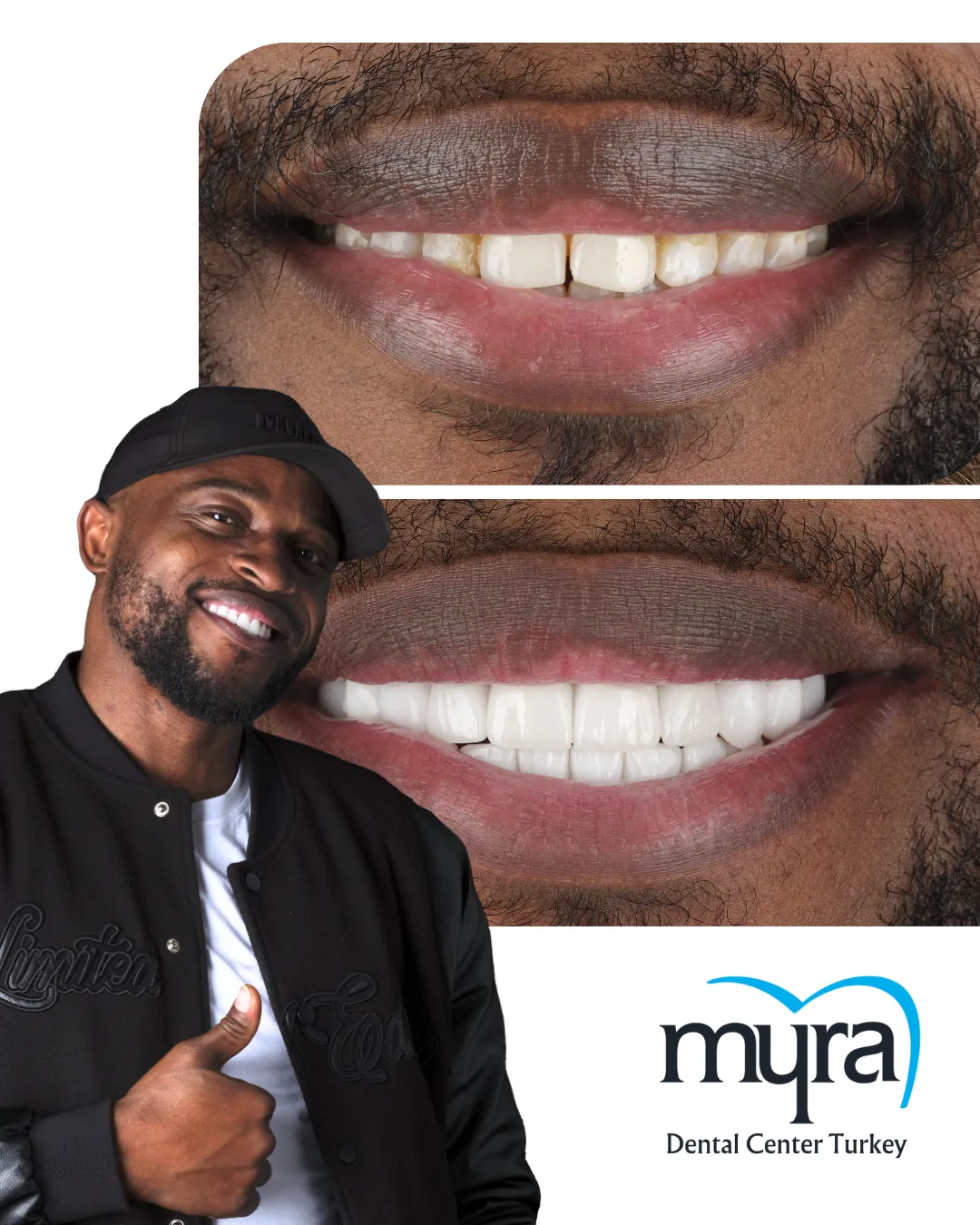
Turkey teeth pictures with bl1
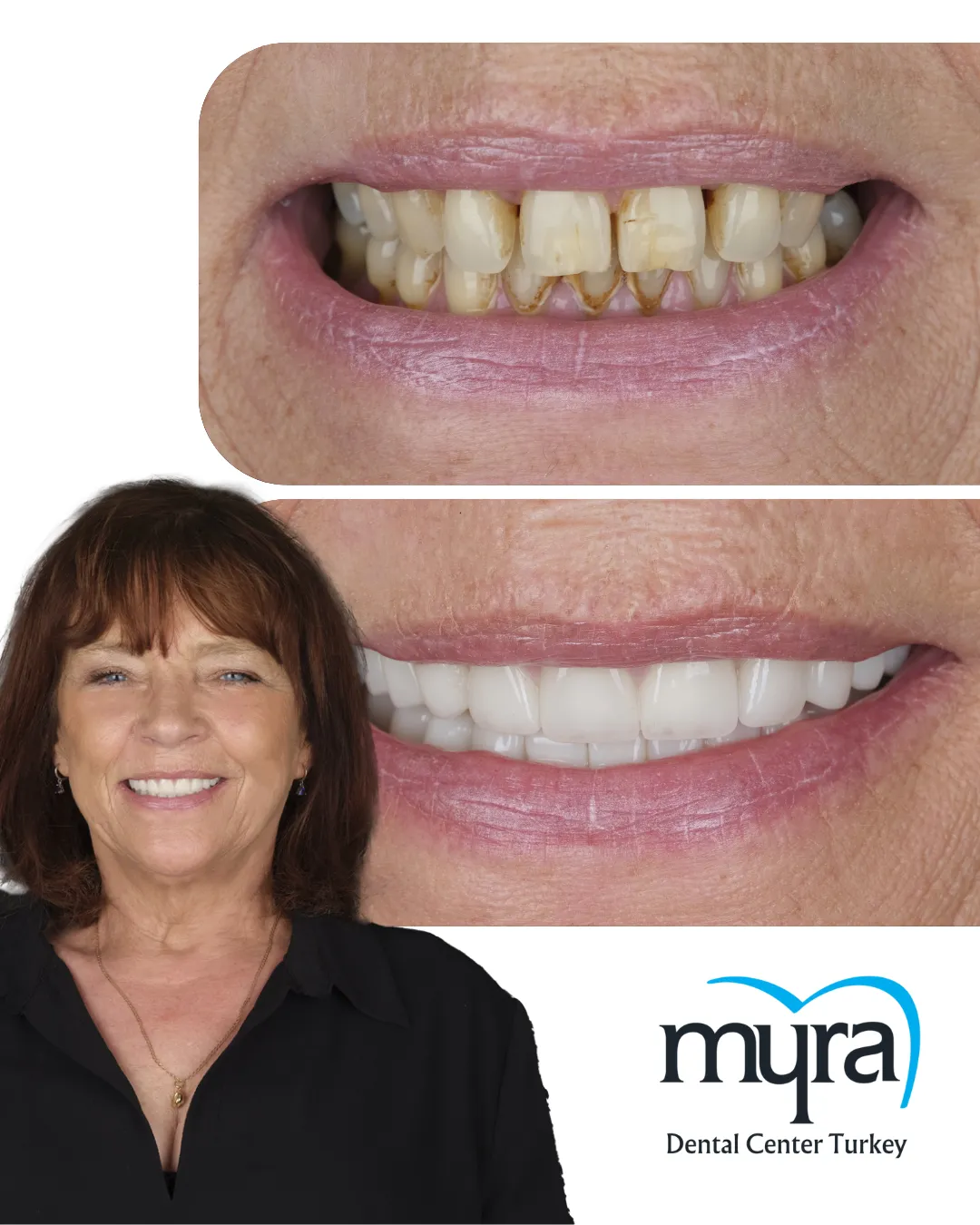
Turkey teeth pictures with bl3
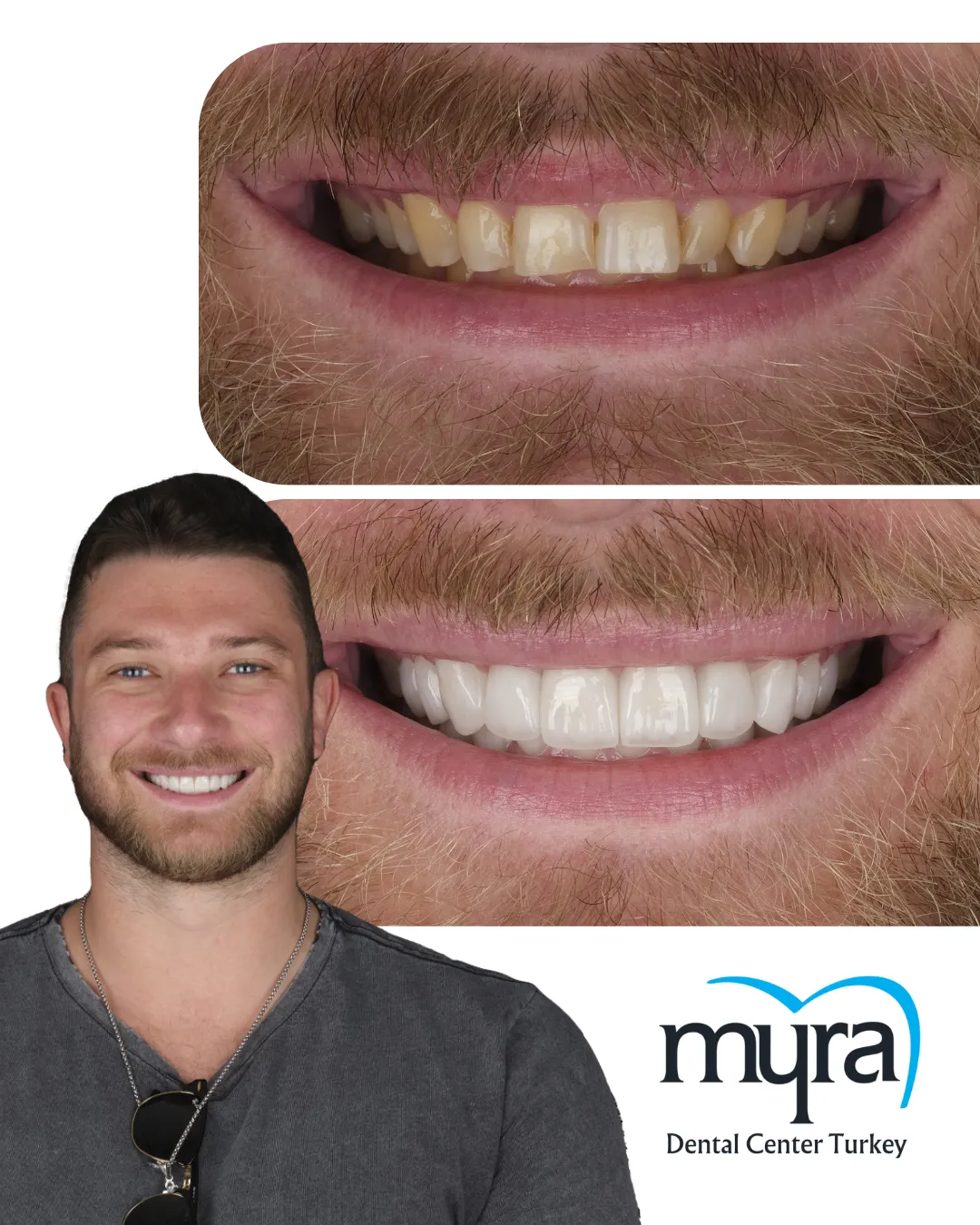
Turkey teeth pictures with b1
How Long Does It Take to Install the Zirconia Veneers?
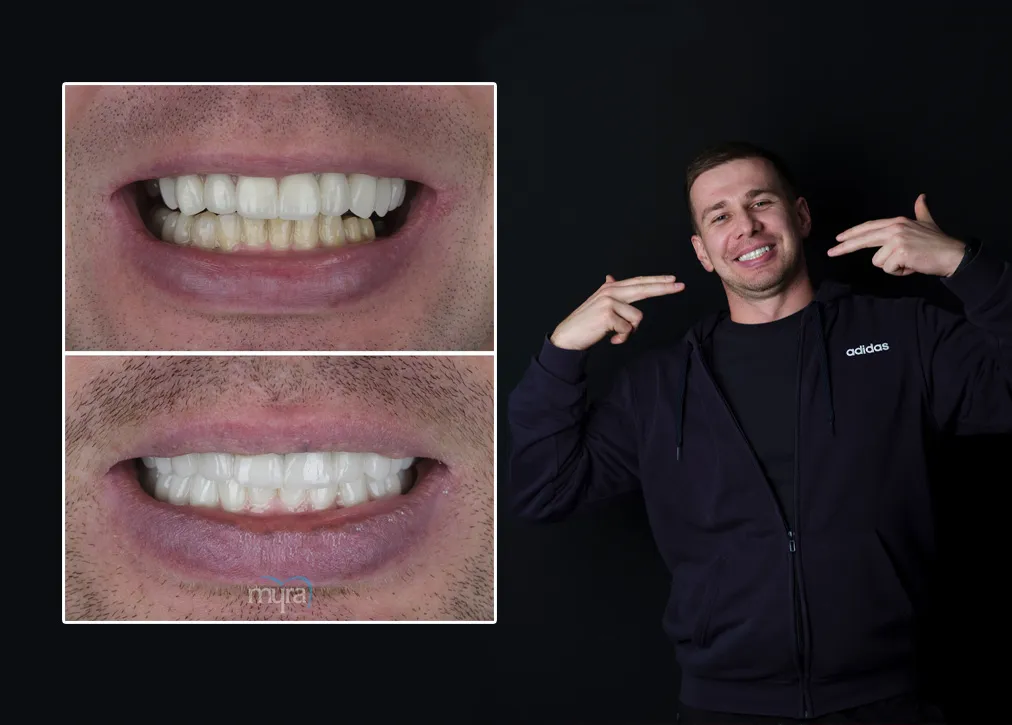
It takes one week to install the zirconia veneers. The exact time required for the zirconia veneer installation process varies based on individual factors and any additional steps needed. It involves multiple appointments over one week.
The process of installing zirconia veneers unfolds in several key stages. It all begins with the initial consultation and appointment booking, a variable duration where individuals discuss expectations with their dentist to determine suitability for zirconia veneers. The crucial first step allows for the identification of any dental issues that impact eligibility. The next step is teeth trimming, when the dentist files the teeth down to a veneer-thickness, shaping them so that they blend in with the surrounding teeth and create a strong bond.
The dentist embarks on creating a gum and teeth impression following the trimming, a process spanning up to one day. The impression becomes the blueprint for crafting zirconia veneers at the dental lab. A variable-duration temporary fix is implemented for cases involving a substantial removal of tooth structure, providing interim protection while awaiting the permanent veneers.
The colour, fit, and shape evaluation stage occurs during the next visit, with the dentist meticulously assessing how the veneers align with the natural teeth. Adjustments are made as needed to ensure the right shape and colour, often fine-tuning with trial paste to achieve the desired aesthetic.
The setting of the veneers is the final step, and it takes only minutes but is a critical concluding step. It involves etching the tooth's surface, applying bonding agents, placing cement inside the veneers, and securing them in place. The curing process is swift, with a curing light activating the catalyst in the cement and bonding agent, solidifying the permanent veneers in about a minute. The stages of veneer placement span approximately three weeks, incorporating these intricate and purposeful steps to achieve optimal results.
What are the Advantages of Zirconia Veneers Over Other Types of Dental Restoration?
The advantages of zirconia veneers over other types of dental restoration are focused on offering patients a dental restoration that is attractive and reliable. One of the key strengths of zirconia veneers lies in their outstanding long-term reliability. Zirconia is referred to as "ceramic steel." It is approximately 5 times stronger than natural tooth enamel, ensuring a long-lasting and resilient dental restoration. The combination of aesthetics, strength, and longevity positions zirconia veneers as a preferred choice for individuals seeking durable and visually appealing dental restorations.
Zirconia veneers offer a natural and visually appealing appearance beyond their strength. The material's high translucency allows light to pass through, replicating the optical properties of natural teeth. It results in a lifelike and seamlessly blended smile, effectively addressing cosmetic concerns.
The versatility of Zirconia veneers is noteworthy, making them suitable for a range of dental issues such as discolouration, chipping, and misalignment. Their adaptability extends to the front and back teeth, providing a comprehensive solution for various dental restoration needs.
The tooth preparation process for zirconia veneers is minimally invasive, preserving more of the natural tooth structure compared to some other restoration methods. Its conservative approach contributes to the health of the teeth.
Biocompatibility is a further major benefit of zirconia veneers. Zirconia, a mineral that the body tolerates, is a suitable option for individuals with metal allergies. It ensures that the restoration is aesthetically pleasing and compatible with the patient's health.
Zirconia veneers exhibit excellent stain resistance against common culprits such as coffee, tea, wine, and nicotine. Its resistance maintains the restoration's aesthetic appeal and contributes to its long lifespan.
Zirconia veneers, which are renowned for their long life expectancy, are capable of being maintained properly for up to 10 years. Their durability makes them a reliable and enduring choice for individuals seeking a lasting dental restoration solution.
Reduced tooth sensitivity is an additional benefit of zirconia veneers, offering a comfortable and functional solution for individuals with sensitive teeth. The precision fit of these custom-crafted veneers ensures optimal alignment and integration with the individual's natural teeth.
Zirconia veneers are tissue-friendly, reducing the risk of gum irritation or inflammation. Its characteristics contribute to the comfort and health of the surrounding oral tissues, enhancing the patient’s experience. Dental implant restorations in Turkey exemplify the country's dedication to offering sophisticated and all-encompassing dental treatment options.
What are the Disadvantages of Zirconia Veneers from Other Types?
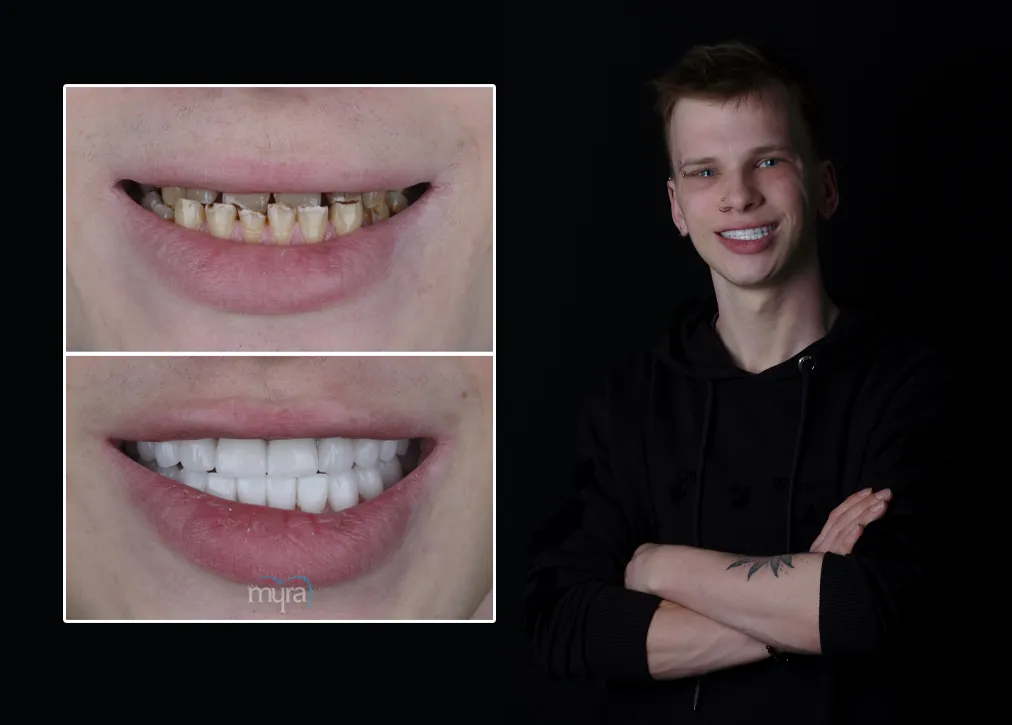
The disadvantages of Zirconia Veneers from other types are listed below.
- Opaque Appearance: One potential disadvantage of zirconia crowns is their opaque appearance, particularly in monolithic zirconia crowns made solely from zirconia. The opacity makes them less natural-looking, especially for teeth in visible areas of the mouth.
- Difficulty in Matching: Achieving a seamless match with the natural teeth is challenging due to the material's opacity. The difficulty in matching is more pronounced in monolithic zirconia crowns, impacting their aesthetic integration with adjacent teeth.
- Wear on Opposing Teeth: Some concerns have been raised about the hardness of zirconia potentially causing wear and tear on opposing teeth. Some dentists are hesitant to use zirconia crowns because of such concerns.
- Potential for Chipping or Delamination: Some dentists opt for layered crowns composed of zirconia with a porcelain overlay to address the opacity issue. It improves the look of the material and makes it more colour-matchable, however, it renders chipping or delamination (layer separation) slightly more probable.
- Colour Matching Challenges: The opaque nature of zirconia poses challenges in colour matching, particularly in achieving the nuanced shades and translucency of natural teeth. It is more noticeable in the front teeth, where aesthetics are a primary concern.
- Cost Considerations: Zirconia crowns are relatively more expensive than alternative materials. Cost considerations are a factor for some patients, especially if budget constraints are a concern.
- Allergic Reactions: Some individuals experience allergic reactions to the components of zirconia in rare cases. Dentists need to consider patient medical history and potential sensitivities.
- Complexity in Repair: Repairing zirconia crowns is more complex compared to other restorative options. The process involves replacement rather than straightforward repairs.
What Are the Materials Used in Making Zirconia Veneers?
The materials used in making Zirconia Veneers are listed below.
- Zirconium Oxide (Zirconia): Zirconium oxide, usually referred to as zirconia, serves as the primary material for zirconia veneers. The extraordinary strength of the material makes it very long-lasting and resistant to damage. Zirconia's robust nature ensures the longevity of dental restorations, providing a reliable solution for individuals seeking durable and aesthetically pleasing veneers.
- Yttria-Stabilized Tetragonal Zirconia Polycrystal (3Y-TZP): The framework of zirconia veneers incorporates Yttria-Stabilised Tetragonal Zirconia Polycrystal (3Y-TZP), enhancing the strength and stability of the restoration. The component contributes to the structural integrity of the veneers, ensuring they withstand the forces and pressures experienced during daily dental functions.
- Dental Porcelain (Veneering Material): Dental porcelain serves as the veneering material applied over the zirconia framework. The layer is crucial for achieving a natural and translucent appearance that mimics the look of natural teeth. Dental porcelain enhances the aesthetic appeal of zirconia veneers and provides the desired translucency, contributing to a lifelike and visually pleasing result. The combination of these materials results in a harmonious combination of strength and a visually pleasing look in zirconia veneers.
What Are the Signs that Indicate Zirconia Veneers May Need Replacement?
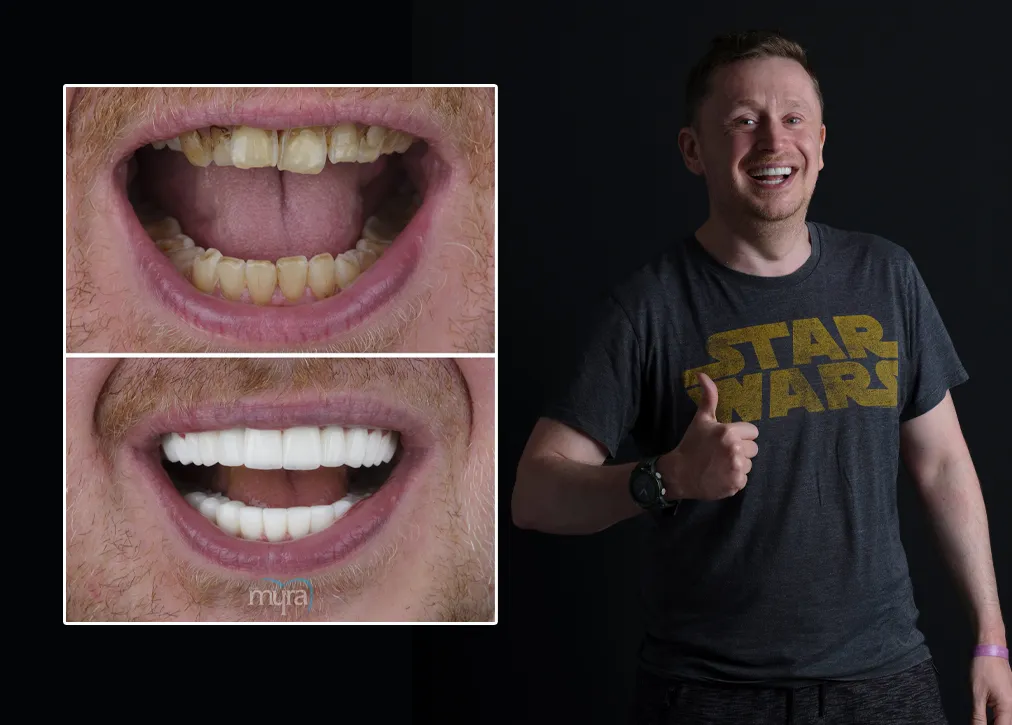
The signs that indicate zirconia veneers may need replacement are listed below.
- Darkening of Veneers: The sign manifests as a change in colour, and if the veneers start to darken, it suggests underlying problems that merit attention.
- Staining of Veneers: Stains on the veneers compromise their appearance. Persistent discolouration signifies the need for replacement to restore a bright and natural look.
- Chipped or Cracked Veneers: Visible chips or cracks in the veneers indicate structural damage. The replacement is necessary if it compromises the aesthetics and functionality of the teeth.
- Separation from Gums: It's a sign of adhesive or bonding problems if veneers begin to pull away from gums. The separation impacts the integrity of the veneers and requires prompt attention.
- Veneers Being Too Big: Ill-fitting veneers that appear disproportionately large lead to discomfort and aesthetic concerns. Replacement is necessary to achieve the right fit and balance.
- Rough Edges: The presence of rough edges on the veneers is a sign of wear or damage. Smooth edges contribute to comfort and aesthetics, making replacement a consideration.
- Spaces Between Gums and Veneers: The development of spaces or gaps between the gums and veneers indicates issues with fit or bonding. Addressing the gaps involves replacing the veneers for an optimal outcome.
- Visible Damage: Any visible damage, including fractures or irregularities, must prompt a dental evaluation. Replacement is necessary to ensure the longevity and effectiveness of the veneers.
What Are the Things You Can Do with Zirconia Veneers?
The things you can do with a zirconia veneer are listed below.
- One technique for enhancing the appearance of teeth is zirconia veneers. They effectively cover imperfections, such as discolouration, stains, and irregularities, providing a visually pleasing and uniform smile.
- People who suffer from discoloured teeth are able to feel better with zirconia veneers. The veneers successfully conceal the discolouration, whether it is due to internal factors or external stains, producing a brighter and whiter smile.
- Individuals with misshapen or irregularly sized teeth benefit from zirconia veneers. The veneers are customised to achieve a harmonious and balanced tooth shape, improving dental symmetry.
- Veneers made of zirconia are a long-term fix for damaged teeth. The veneers cover and protect the damaged tooth structure, restoring functionality and aesthetics.
- People who have spaces between their teeth have a perfectly aligned smile with the help of zirconia veneers, a non-invasive alternative. The veneers effectively close gaps, enhancing the alignment of the smile.
- A beautiful, natural-looking smile is within reach with the help of zirconia veneers. The veneers are designed to achieve a consistent and attractive dental appearance, whether they are applied to one tooth or several teeth.
- The longevity and resilience of zirconia veneers are well-known facts. They provide lasting results once applied, maintaining their appearance and functionality for an extended period of time.
- Zirconia veneers resist staining from common sources such as coffee, tea, wine, and nicotine. The stain resistance ensures that the veneers maintain their aesthetic appeal over time, contributing to a long-lasting bright smile.
- Zirconia veneers boost an individual's confidence by addressing various dental concerns and improving the appearance of the smile. A confident smile has positive effects on social interactions and self-esteem.
- A conservative way to improve the teeth, zirconia veneers require less tooth preparation than some other options. It makes them a popular choice for individuals seeking aesthetic improvements with a reduced impact on natural dental structure. The approach to getting dental veneers in Turkey involves personalised consultations, ensuring individual needs and preferences are considered.
Are There Any Alternatives to Zirconia Veneers for Restoring Damaged Teeth?
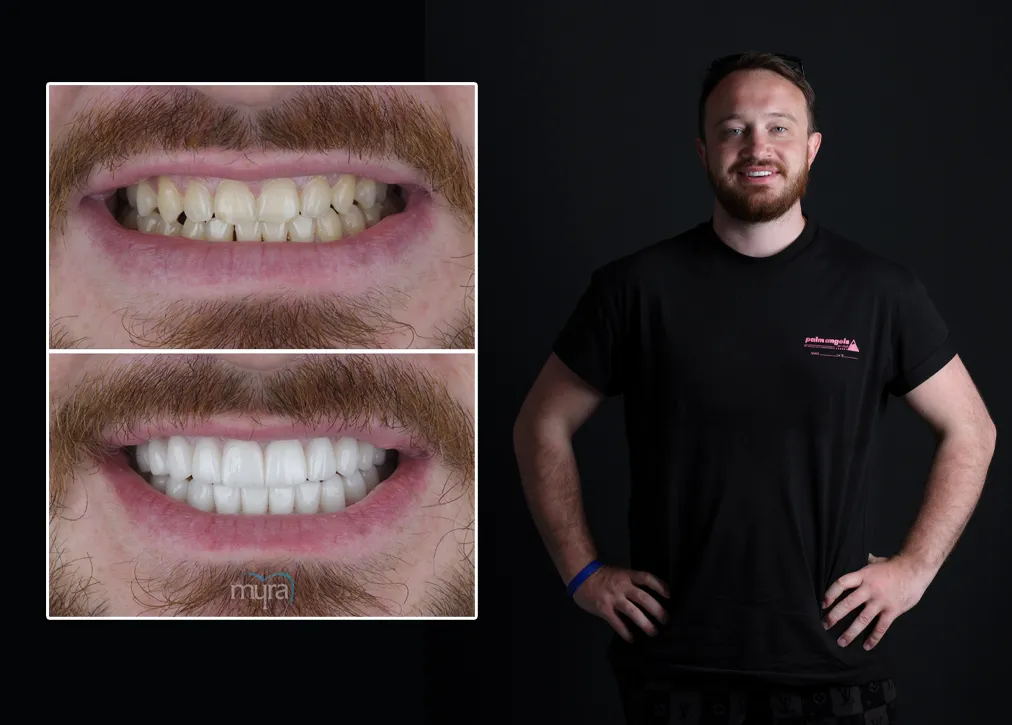
Yes, there are three alternatives to zirconia veneers for restoring damaged teeth, which include crowns, dental bonding and in-office teeth whitening. Each option comes with its own unique advantages and disadvantages, and the choice between veneers and these other options is determined by individual preferences, dental conditions, and treatment goals. Consulting with a dentist helps determine the most suitable option for specific needs.
Crowns are tooth-like caps that dentists place over existing teeth, offering strength and durability. They are suitable for fixing cracked, chipped, or decayed teeth. Crowns come in various types, including gold, porcelain fused to metal (PFM), and zirconia, providing versatility, strength, and long-lasting restoration.
Dental bonding is a cost-effective alternative to veneers, particularly for fixing broken, chipped, or misshapen front teeth. It involves applying tooth-coloured bonding material to the tooth's surface, shaping it to fit naturally, and cementing it with UV light. Dental bonding is faster and less invasive than veneers because it removes less enamel.
In-office teeth whitening is an affordable alternative for individuals seeking a brighter smile without altering their natural tooth structure. The procedure, such as Zoom whitening, involves using whitening gel and light activation to whiten teeth. It is a non-invasive option that provides noticeable results in a short time.
Can Zirconia Veneers Cause Tooth Sensitivity?
Yes, zirconia veneers can cause tooth sensitivity following their placement, which is a potential but not universal occurrence. The sensitivity is associated with the tooth preparation process, which involves the removal of a certain amount of enamel to accommodate the veneers. Enamel removal exposes the dentin layer of the tooth, which contains nerve endings, leading to heightened sensitivity.
Zirconia itself is a biocompatible and inert material, meaning it does not cause sensitivity. The material is known for its durability, resistance to wear, and natural appearance, making it a popular choice for dental restorations. The sensitivity that some individuals experience is more related to the preparation of the natural tooth than the zirconia veneer itself.
The degree of sensitivity varies among patients, and some do not experience it at all. Dentists take precautions to minimise sensitivity by using local anaesthesia during the preparation process, but post-procedure discomfort is normal. It's crucial for individuals considering zirconia veneers to have a thorough discussion with their dentist about potential side effects, including sensitivity, and to follow post-procedure care guidelines diligently.
Post-procedure care involves avoiding extreme temperatures, such as hot or cold foods and beverages, and using toothpaste formulated for sensitive teeth. Most people find that the benefits of zirconia veneers outweigh the initial discomfort as the teeth become used to having them and the discomfort diminishes. The dentist is able to monitor for any sensitivity issues and treat them during routine visits to the dentist.
How much does a Zirconia Veneers Cost?
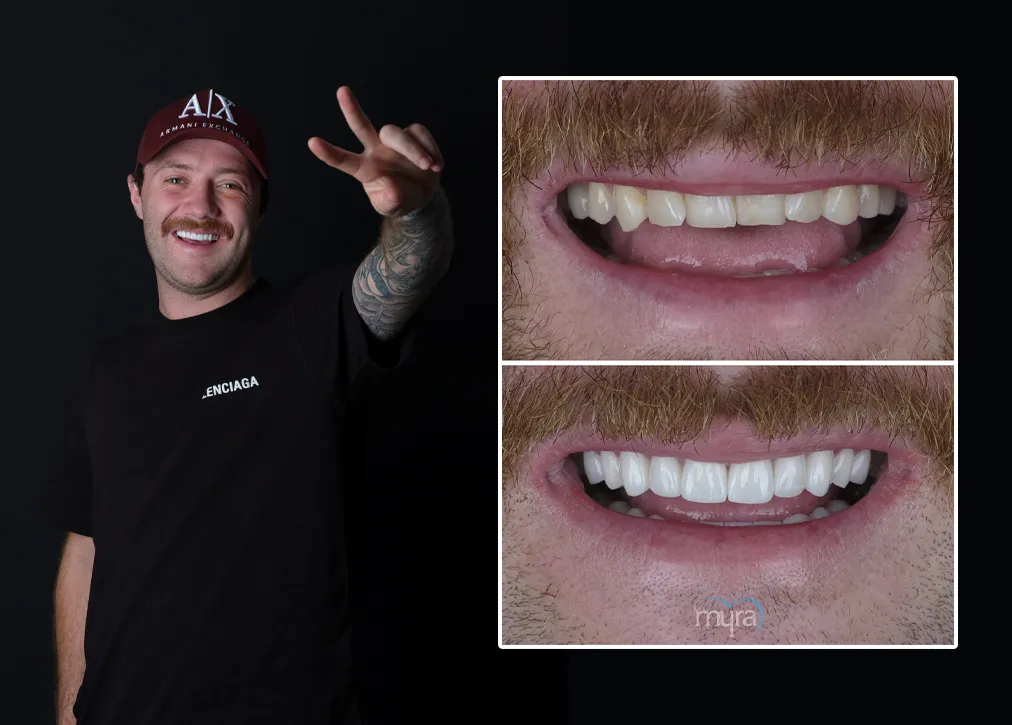
The cost of zirconia veneers is around $1000 to $2000 in the USA. One of the factors influencing the cost is the location of the dental clinic. Dental clinics situated in city centres or central business districts have higher charges to cover additional expenses, including taxes. Clinics in more remote areas offer lower prices, although indirect costs have the potential to remain significant.
Another crucial factor is the type of veneer chosen. Zirconia veneers, known for their strength and tooth-coloured appearance, come with a specific cost range. The quality of materials used in the veneers significantly affects their price, with higher-quality materials commanding a higher cost.
The number of veneers required for the procedure is a determinant of the total cost. The application of veneers is done one tooth at a time, so the price is usually determined per tooth. Cosmetic dentists offer special deals or packages for multiple veneers, providing potential cost savings.
Comparing the cost of veneers with other cosmetic dental treatments, such as teeth whitening, dental bonding, or dental crowns, is crucial for making an informed decision. Each option has its own pricing structure, and individuals need to weigh the pros and cons of each procedure.
Insurance coverage for veneers is generally limited, as these procedures are often considered cosmetic and elective. Individuals seeking zirconia veneers need to explore alternative payment options, such as Health Savings Accounts (HSAs), Flexible Spending Accounts (FSAs), or credit cards. These financial tools help facilitate the financing of the veneers, providing flexibility in payment.
Consider the potential maintenance and consultation costs associated with zirconia veneers. Regular check-ups, examinations and oral hygiene practises incur additional charges, and individuals must be aware of these aspects when budgeting for their veneer procedure.
Zirconia veneers offer a competitive and cost-effective choice for a smile makeover, but the cost depends on factors such as location, the type and number of veneers, and the materials used. Understanding the elements allows individuals to make an informed decision and find a trusted cosmetic dentist for their specific dental needs.
How much does a Zirconia Veneers Cost in Turkey?
The cost of zirconia veneers in Turkey, particularly in Antalya, is priced at £210. The fee reflects the popularity of zirconia veneers in the region, drawing local and international patients seeking quality dental care at competitive prices.
Materials, involved body parts, and particular procedures are the main determinants of the cost of zirconia veneer surgery. The choice of materials significantly affects the cost. Zirconia veneers are renowned for their aesthetic and natural appearance, particularly when used for the restoration of anterior teeth and smile design applications. The quality and type of zirconium materials selected for the procedure contribute to the variability in costs.
The expertise of the dentist is another crucial factor influencing the cost of zirconia veneer surgery. Skilled and experienced dentists charge higher fees for their services, reflecting their proficiency in delivering successful outcomes. The level of expertise ensures that the veneers are applied with precision and attention to detail, meeting the expectations of patients.
Individual considerations play a role in determining the cost of zirconia veneer surgery. Factors such as the specific dental needs of the patient, the complexity of the procedure, and any additional services required contribute to the overall pricing.Antalya, Turkey, has positioned itself as a prominent destination for dental tourism, offering high-quality dental treatments at reasonable prices. The affordability of veneers cost in Turkey does not compromise the use of high-quality materials and expert dental services. The commitment to using certified zirconium materials aligns with health standards, ensuring the safety of patients undergoing zirconia veneer procedures. The emphasis on quality service coupled with a cost-effective approach has made Antalya an attractive choice for individuals seeking zirconia veneer treatments, providing a positive experience for people looking to enhance their smiles.
Zirconia Veneers FAQ
We try to give clear answers to your questions as best we can. We are getting a lot of questions about zirconia treatment in Turkey and zirconia veneers prices in Antalya. But apart from these, there are dozens of different questions. You can find answers to all these questions in Zirconium veneer frequently asked questions section.
In the 5 days period for the treatment is expected that you can have 3 appointments to fulfill your
dental crowns for smile design. And patients usually prefer 7 days minimum to get treatment for 5 days except the flight arrival and departure days.
Any products such as whitening products or cosmetic dentistry, do not work on teeth whitening for your dental crowns. In the case of maintaining good oral hygiene, it will take many years to discolour for your
E.max© crowns. Even if you are smoking, it will still take many years to the shade to be darken.
We have a vita colour shade card including 30 tooth colours which called universal tooth shading system. Known as BL1 and Hollywood white (the whitest one available in the world.) can be applied. We have all opportunities that available on universal colour range, such as Hollowood white to natural white to yellow and even brown. The most popular colours are Hollywood white and natural white. Within your consultation, we discuss with you about your choise to make you have the perfect matched colour with your eye, skin, hair colour, and other facial details.
Your all treatment including cosmetic treatments such as dental crowns with smile design is effected with local anesthetic which numbs the related area. Therefore you will not feel the treatment.
On your first appointment, you will get a full consultation in our clinic, including tomographic
X-Ray to check the teeth under your gum line. After this consultation we will make any required preparations. If required, we will provide you temporary teeth. Therefore there is no need to hesitate this treatment will affect your daily life till you return a few days later for trial fitting. At following appointment we will check if the adjustments need to be made or not before your final appointment. On the final appointment, your new dental crowns will be placed into area. If there is a need for further adjustment, this will be done in the next 24 hours.
Any finance plans including monthly payments can not be provided for our patients.
At Myra Dental Clinic we believe in patient satisfaction, in this sense we arrange everything upon your availability; just let us know which dates you want to have your appointment with our dental team or ask us for arranging your holiday for you. If it’s your first visit to Turkey, before we organise your whole dental holiday at your request. We arrange everything including; your first quotation for your flight tickets and hotel along with bring you to our dental clinic to get your treatment and bring back you to your hotel again. Our aim is to make your dental holiday comfortable and make your treatment easy for you – as we already have for many patients from all around the World till now.
Please note that we do not get your credit or debit card details on the phone, for this reason we are not able to book the flights in behalf of you.
If you want us to arrange your accommodation in Antalya, we have connections lots of great hotels including boutique to luxury 5 stars and all-inclusive resorts changing upon budget to budget. Upon you request, we can make your reservations for your hotel, then you will pay after arrival. Also we would like to inform you that we do not get any commissions for any of travel services we give. Therefore payments are made directly to related company upon your arrival by yourself.
Zirconia Veneers Prices in Turkey determines the labor cost and the price of zirconium called precious metal. The price of the precious mineral the price of zirconium tooth varies from year to year, as the price of zirconium material varies from year to year. The prices that can be given on the internet and over the phone, by law, only include the labor fee. After the examination, the exact price is given as the amount of zirconium to be used is determined. Those who are curious about zirconium dental veneer prices should also get a direct examination instead of internet or telephone.
Porcelain veneers are made with dental ceramics. Because Dental ceramics are a very fragile material, metal bridges are used to support ceramics in this technique. The metal that remains at the bottom and acts as a support is usually a material that does not oxidize or interact in any way, such as gold, platinum, or palladium. As these materials are quite expensive, the material known as stainless steel, which is an alloy of chromium cobalt, is used. Stainless steel is blackened to stick to the tooth this can lead to oxidation. This can lead to discoloration of the gums and withdrawal of the gums in the long term. Because the metal used in this metal-backed veneer does not fit with the gum, problems such as accumulation of food residues may occur in the tooth. This application, which provides an advantage as a more economical solution, is shorter-lived and durable than zirconium.
Zirconium is a semi-metal and is a biologically compatible material used very often in medicine. Zircon is a material that has light permeability and has a higher robustness than metal. The fact that the material has light transmittance allows it to directly reflect the color of the tooth and thus make a natural appearance. A bonding occurs between zirconium and the gum, resulting in teeth that the person can use for many years. One of the advantages of zirconium is that it prevents the accumulation of food debris in the teeth due to its high alignment with the gum. However, this material is more expensive than porcelain or dental ceramics supported with metal. Zirconium veneer is recommended for healthy use of the constructed teeth for many years.
Zirconia dental veneer is among the top-level dental veneer treatments. Although health insurances are stakeholders in each patient regarding the cost of dental veneer treatment, there are certain criteria. A certain percentage of all treatment can be covered by insurance. But you can get the necessary information by calling the insurance company on this matter.
Zirconium is very often used for medical purposes. Being semi-metal makes it very durable. It is not possible to break the zirconium coating if it does not suffer very serious trauma. Perhaps the most robust of all dental veneers is zirconium veneer. So you can count on zirconium for durability. It is sturdy and durable.















